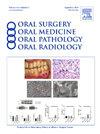口腔黏膜潜在恶性疾病炎症微环境的免疫组织化学和分子分析
IF 1.9
3区 医学
Q2 DENTISTRY, ORAL SURGERY & MEDICINE
Oral Surgery Oral Medicine Oral Pathology Oral Radiology
Pub Date : 2025-07-21
DOI:10.1016/j.oooo.2025.04.010
引用次数: 0
摘要
最近的研究表明,肿瘤微环境的性质和浸润性免疫细胞可以显著改变口腔上皮遗传畸变的结果。尽管它们在癌症进展中的作用尚不完全清楚,但在许多实体瘤中,这些浸润细胞与患者的不良或较好的预后密切相关。本研究分析了OPMD和已知组织病理模拟物中免疫浸润细胞的表型和分子表达。材料和方法从ECU和UNC口腔颌面病理学实验室中选择诊断为中度至重度口腔上皮发育不良(OED)的20份存档组织样本。用CD4/CD8和CD163/STAT1抗体对每个病例进行IHC/DIF双染色,并进行自动组织形态学数字分析。研究的第二部分涉及空间转录组学,以鉴定FFPE组织中的基因和细胞类型。大量RNA测序(Illumina, CA)目前正在进行,以测量整个细胞群的平均基因表达,并确定研究组之间的差异。结果初步结果显示,STAT1/CD163+巨噬细胞主要分布于OED上皮内,与CD4+细胞分布相似。上皮内CD8+淋巴细胞分布与高级别OED的发育不良程度相关,这一发现与STAT1/CD163+细胞的少量存在相关。与OLP相比,观察到OED中炎性上皮内细胞(CD8+细胞和STAT1/CD163+巨噬细胞)的存在增加。在OED中,转录信号显著增加,特别是来自细胞毒性细胞。结论本研究的初步结果提示,由癌前病变引起的炎症可作为恶性转化及其与其他粘膜炎性疾病显微分离的替代指标。本文章由计算机程序翻译,如有差异,请以英文原文为准。
Immunohistochemical and molecular analysis of the inflammatory microenvironment of oral mucosal potentially malignant disorders
Introduction
Recent studies have shown that the nature of the tumor microenvironment and infiltrating immune cells can significantly modify the outcome of genetic aberration in the oral epithelium. Although their role in cancer progression is not fully understood, these infiltrating cells have been strongly correlated with a poor or better prognosis for the patient in many solid tumors. This study analyzes the phenotypic and molecular expression of immune infiltrating cells in OPMD and known histopathologic mimickers.
Materials and Methods
Twenty archived tissue samples were selected from ECU, and UNC Oral and Maxillofacial Pathology Laboratories diagnosed with moderate to severe oral epithelial dysplasia (OED). Dual IHC/DIF staining was carried out on each case with CD4/CD8 and CD163/STAT1 antibodies, and automated histomorphometric digital analysis was performed. The second part of the study involves spatial transcriptomics to identify genes and cell types in FFPE tissue. Bulk RNA sequencing (Illumina, CA) is currently being performed to measure the average gene expression across the population of cells and identify differences between the study groups.
Results
Preliminary results show that STAT1/CD163+ macrophages were mainly found underlying the epithelium in OED with similar distribution to CD4+ cells in the same compartment. Intraepithelial CD8+ lymphocyte distribution correlated with the degree of dysplasia in high-grade OED, and that finding correlates with a small presence of STAT1/CD163+ cells. Compared with OLP, an increased presence of inflammatory intraepithelial cells in OED (CD8+ cells and STAT1/CD163+ macrophages) was observed. A significant increase in transcriptional signals appears in OED, specifically from cytotoxic cells.
Conclusions
The preliminary results of our study suggest that the inflammation elicited by premalignant conditions could be used as a surrogate indicator of malignant transformation and its microscopic separation from other mucosal inflammatory diseases.
求助全文
通过发布文献求助,成功后即可免费获取论文全文。
去求助
来源期刊

Oral Surgery Oral Medicine Oral Pathology Oral Radiology
DENTISTRY, ORAL SURGERY & MEDICINE-
CiteScore
3.80
自引率
6.90%
发文量
1217
审稿时长
2-4 weeks
期刊介绍:
Oral Surgery, Oral Medicine, Oral Pathology and Oral Radiology is required reading for anyone in the fields of oral surgery, oral medicine, oral pathology, oral radiology or advanced general practice dentistry. It is the only major dental journal that provides a practical and complete overview of the medical and surgical techniques of dental practice in four areas. Topics covered include such current issues as dental implants, treatment of HIV-infected patients, and evaluation and treatment of TMJ disorders. The official publication for nine societies, the Journal is recommended for initial purchase in the Brandon Hill study, Selected List of Books and Journals for the Small Medical Library.
 求助内容:
求助内容: 应助结果提醒方式:
应助结果提醒方式:


